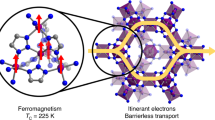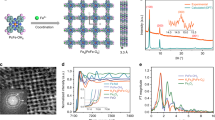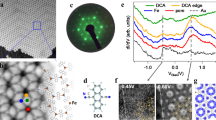Abstract
Crystal engineering—the planning and construction of crystalline supramolecular architectures from modular building blocks—permits the rational design of functional molecular materials that exhibit technologically useful behaviour such as conductivity and superconductivity1, ferromagnetism2 and nonlinear optical properties3. Because the presence of two cooperative properties in the same crystal lattice might result in new physical phenomena and novel applications, a particularly attractive goal is the design of molecular materials with two properties that are difficult or impossible to combine in a conventional inorganic solid with a continuous lattice. A promising strategy for creating this type of ‘bi-functionality’ targets hybrid organic/inorganic crystals comprising two functional sub-lattices exhibiting distinct properties. In this way, the organic π-electron donor bis(ethylenedithio)tetrathiafulvalene (BEDT-TTF) and its derivatives, which form the basis of most known molecular conductors and superconductors1, have been combined with molecular magnetic anions, yielding predominantly materials with conventional semiconducting or conducting properties4,5, but also systems that are both superconducting and paramagnetic6,7. But interesting bulk magnetic properties fail to develop, owing to the discrete nature of the inorganic anions. Another strategy for achieving cooperative magnetism involves insertion of functional bulky cations into a polymeric magnetic anion, such as the bimetallic oxalato complex [MnIICrIII(C2O4)3]-, but only insoluble powders have been obtained in most cases8,9,10,11,12. Here we report the synthesis of single crystals formed by infinite sheets of this magnetic coordination polymer interleaved with layers of conducting BEDT-TTF cations, and show that this molecule-based compound displays ferromagnetism and metallic conductivity.
This is a preview of subscription content, access via your institution
Access options
Subscribe to this journal
Receive 51 print issues and online access
$199.00 per year
only $3.90 per issue
Buy this article
- Purchase on Springer Link
- Instant access to full article PDF
Prices may be subject to local taxes which are calculated during checkout



Similar content being viewed by others
References
Williams, J. M. et al. Organic superconductors—new benchmarks. Science 252, 1501–1508 (1991).
Miller, J. S. & Epstein, A. J. Organic and organometallic magnetic materials—designer magnets. Angew. Chem. Int. Edn Engl. 33, 385–415 (1994).
Zyss, J. (ed.) Molecular Nonlinear Optics (Academic, New York, 1994).
Day, P. et al. Structure and properties of tris[bis(ethylenedithio)-tetrathiafulvalenium]tetrachloro-copper(II) hydrate, (BEDT-TTF)3CuCl4.H2O: first evidence for coexistence of localized and conduction electrons in a metallic charge-transfer salt. J. Am. Chem. Soc. 114, 10722–10729 (1992).
Coronado, E. et. al. Magnetic molecular metals based on the organic donor BET-TTF (BET-TTF bis(ethylenethio)tetrathiafulvalene). Adv. Mater. 9, 984–987 (1997).
Kurmoo, M. et al. Superconducting and semiconducting magnetic charge transfer salts: (BEDT-TTF)4AFe(C2O4).3C6H5CN (A = H2O, K, NH4). J. Am. Chem. Soc. 117, 12209–12217 (1995).
Kobayashi, H. et al. New BETS conductors with magnetic anions (BETS = bis(ethylenedithio)tetraselenafulvalene). J. Am. Chem. Soc. 118, 368–377 (1996).
Coronado, E. et al. Hybrid molecular magnets obtained by insertion of decamethylmetallocenium in layered bimetallic oxalate complexes. Syntheses, structure and magnetic properties of the series [ZIIICp*2][MIIMIII(ox)3] (ZIII = Co, Fe; MIII = Cr, Fe; MII = Mn, Fe, Co, Cu, Zn; Cp* = pentamethylcyclopentadienyl. Chem. Eur. J. 6, 552–563 (2000).
Coronado, E. et al. Hybrid molecular materials formed by two molecular networks. Towards multiproperty materials. Mol. Cryst. Liq. Cryst. 334, 679–691 (1999).
Decurtins, S. et al. in Magnetism: A Supramolecular Function (ed. Kahn, O.) 487–508 (NATO ASI Ser. C484, Kluwer Academic, 1996).
Tamaki, H. et al. Design of metal-complex magnets. Syntheses and magnetic properties of mixed-metal assemblies {[NBu4][MCr(ox)3]}x(NBu+4 = tetra(n-butyl)ammonium ion; ox2- = oxalate ion; M = Mn2+, Fe2+, Co2+, Ni2+, Cu2+, Zn2+). J. Am. Chem. Soc. 114, 6974–6979 (1992).
Mathonière, C. et al. Ferrimagnetic mixed-valency and mixed-metal tris(oxalato) iron (III) compounds: synthesis, structure and magnetism. Inorg. Chem. 35, 1201–1206 (1996).
Beno, M. A. et al. The first ambient pressure organic superconductor containing oxygen in the donor molecule, βm-(BEDO-TTF)3Cu2(NCS)3, Tc = 1.06 K. Inorg. Chem. 29, 1599–1601 (1990).
Nuttall, C. J. & Day, P. Modeling stacking faults in the layered molecular-based magnets AMIIFe(C2O4)3 MII = Mn, Fe; A = organic cation. J. Solid State Chem. 147, 3–10 (1999).
Antorrena, G. et al. Thermal and magnetic study of mixed-metal oxalate-bridged 2d magnets. J. Magn. Magn. Mater. 196–197, 581–583 (1999).
Acknowledgements
V.L. is on leave from the Institute of Problems of Chemical Physics, 142432 Chernogolovka, Russia. We thank K. R. Dunbar for access to X-ray equipment at Texas A&M University and for discussions. This work was supported by the Spanish Ministerio de Ciencia y Tecnología and by the European Union (Network on Molecular Magnetism: From Materials to Devices).
Author information
Authors and Affiliations
Corresponding author
Rights and permissions
About this article
Cite this article
Coronado, E., Galán-Mascarós, J., Gómez-García, C. et al. Coexistence of ferromagnetism and metallic conductivity in a molecule-based layered compound. Nature 408, 447–449 (2000). https://doi.org/10.1038/35044035
Received:
Accepted:
Issue Date:
DOI: https://doi.org/10.1038/35044035
This article is cited by
-
Precise tuning of interlayer electronic coupling in layered conductive metal-organic frameworks
Nature Communications (2022)
-
Theoretical Exploration and Electronic Applications of Conductive Two-Dimensional Metal–Organic Frameworks
Topics in Current Chemistry (2020)
-
Molecular magnetism: from chemical design to spin control in molecules, materials and devices
Nature Reviews Materials (2019)
-
Design of lanthanide metal organic frameworks incorporating dicarboxylate ligands
Journal of Porous Materials (2019)
-
Synthesis, structural determination and antimicrobial evaluation of two novel CoII and ZnII halogenometallates as efficient catalysts for the acetalization reaction of aldehydes
Chemistry Central Journal (2018)
Comments
By submitting a comment you agree to abide by our Terms and Community Guidelines. If you find something abusive or that does not comply with our terms or guidelines please flag it as inappropriate.



